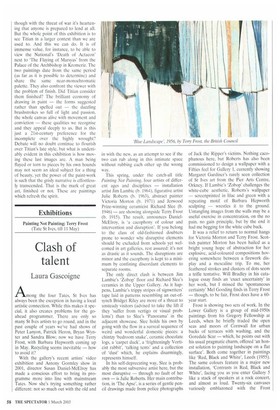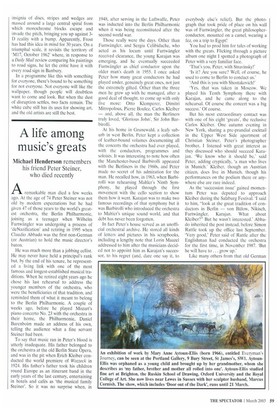Exhibitions
Painting Not Painting; Terry Frost (Tate St Ives, till 11 May)
Clash of talent
Laura Gascoigne
Among the four Tates, St Ives has always been the exception in having a local artistic connection. While this makes it special, it also creates problems for the goahead programmer. There are only so many St Ives artists to go round, and in the past couple of years we've had shows of Peter Lanyon, Patrick Heron, Bryan Wynter and Sandra Blow; now we have Terry Frost, with Barbara Hepworth coming up in May. Recycling seems inevitable — how to avoid it?
With the gallery's recent artists' video exhibition and Antony Gormley show in 2001, director Susan Daniel-McElroy has made a conscious effort to bring its programme more into line with mainstream Tates. Now she's trying something rather different: not so much out with the old and in with the new, as an attempt to see if the two can rub along in this intimate space without rubbing each other up the wrong way.
This spring, under the catch-all title Painting Not Painting, four artists of different ages and disciplines — installation artist Jim Lambie (b. 1964), figurative artist Julie Roberts (b. 1963), abstract painter Victoria Morton (b. 1971) and Jerwood Prize-winning ceramicist Richard Slee (b. 1946) — are showing alongside Terry Frost (b. 1915). The result, announces DanielMcElroy, is 'a cacophony of colour and intervention and disruption'. If you belong to the class of old-fashioned doubters prone to wonder why disruptive elements should be excluded from schools yet welcomed in art galleries, rest assured: it's not as drastic as it sounds. The disruptions are minor and the cacophony is kept to a minimum by confining discordant elements to separate rooms.
The only direct clash is between Jim Lambie's `Zobop' floor and Richard Slee's ceramics in the Upper Gallery. As it happens, Lambie's trippy stripes of signwriters' tape laid in patterns resembling an out-ofsynch Bridget Riley are more of a threat to unsteady visitors (advised to take the lift if they 'suffer from vertigo or visual problems') than to Slee's 'Panorama' in the adjacent showcase. Slee holds his own by going with the flow in a surreal sequence of weird and wonderful domestic pieces: a chintzy 'bedroom snake', ceramic chocolate logs, a 'carpet duck', a 'frighteningly Vorticist rabbit', 'talking tents' and a collection of 'dust' which, he explains disarmingly, represents himself.
In his self-deprecating way, Slee is probably the most subversive artist here, but the most disruptive — through no fault of her own — is Julie Roberts. Her main contribution, in 'The Apse', is a series of gentle pencil drawings made from police photographs
of Jack the Ripper's victims. Nothing cacophanous here, but Roberts has also been commissioned to design a wallpaper with a Fifties feel for Gallery 1, currently showing Margaret Gardiner's rarely seen collection of St Ives art from the Pier Arts Centre, Orkney. If Lambie's `Zobop' challenges the white-cube aesthetic, Roberts's wallpaper — screenprinted in lilac and green with a repeating motif of Barbara Hepworth sculpting — wrestles it to the ground. Untangling images from the walls may be a useful exercise in concentration, on the no pain, no gain principle, but by the end it had me begging for the white cube back.
It was a relief to return to normal hangs for Victoria Morton and Terry Frost. Scottish painter Morton has been hailed as a bright young hope of abstraction for her explosive, acid-coloured compositions hovering somewhere between a firework display and a mescaline trip. To me, her feathered strokes and clusters of dots seem a trifle tentative. Will Bradley in his catalogue essay finds an 'exact uncertainty' in her work, but I missed the 'spontaneous certainty' Mel Gooding finds in Terry Frost — though, to be fair, Frost does have a 60year start.
Frost is showing two sets of work. In the Lower Gallery is a group of mid-1950s paintings from his Gregory Fellowship at Leeds, when he briefly traded the open seas and moors of Cornwall for urban backs of terraces with washing, and the Goredale Scar — which, he points out with his usual pragmatic charm, offered 'an honest solution to painting landscape on a flat surface'. Both come together in paintings like 'Red, Black and White', Leeds (1955). The same colours feature in a major new installation, 'Contrasts in Red, Black and White', facing you as you enter Gallery 5 like a stack of speakers at a rock concert, and almost as loud. Twenty-six canvases variously emblazoned with the Frost insignia of discs, stripes and wedges are massed around a large central spiral from which monochrome blocks escape and invade the pitch, bringing you up against 3D reality with a bump. Apparently, Frost has had this idea in mind for 30 years. On a triumphal scale, it revisits the territory of M17, October 1962' where, in response to a Daily Mail review comparing his paintings to road signs, he let the critic have it with every road sign in Banbury.
In a programme like this with something for everyone, there's bound to be something for not everyone. Not everyone will like the wallpaper, though people will doubtless want to come and look. But when the dust of disruption settles, two facts remain. The white cube still has its uses for showing art, and the old artists are still the best.



















































































 Previous page
Previous page